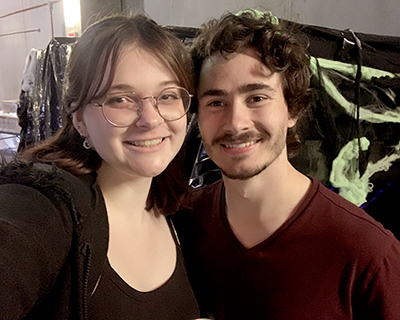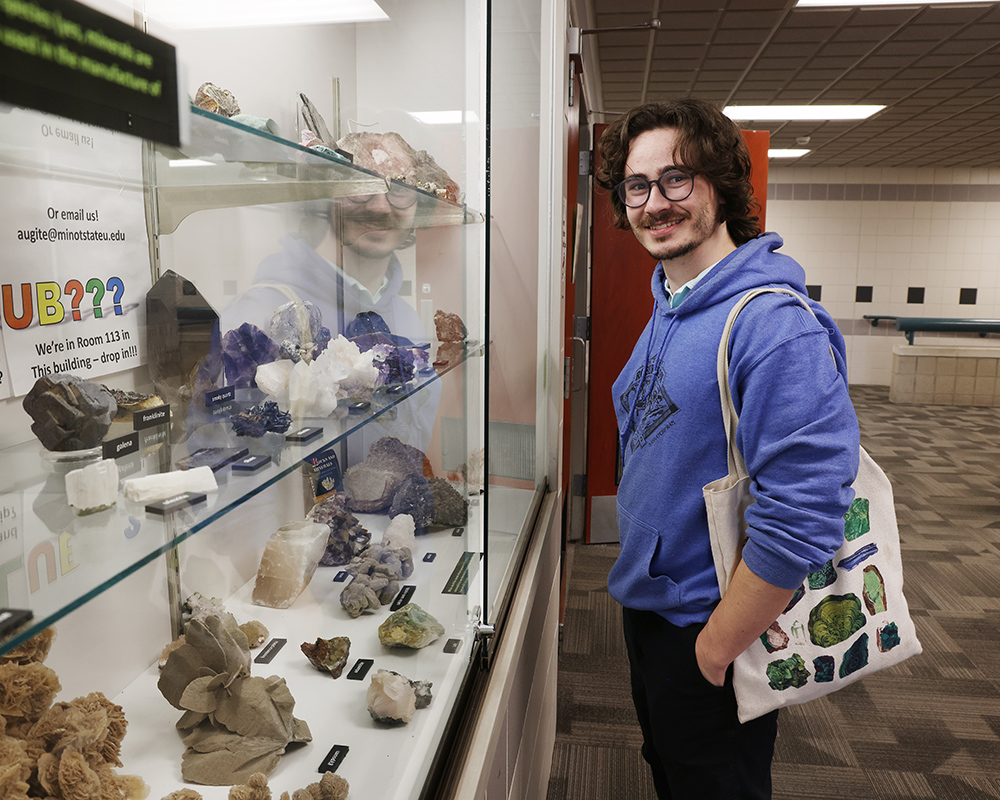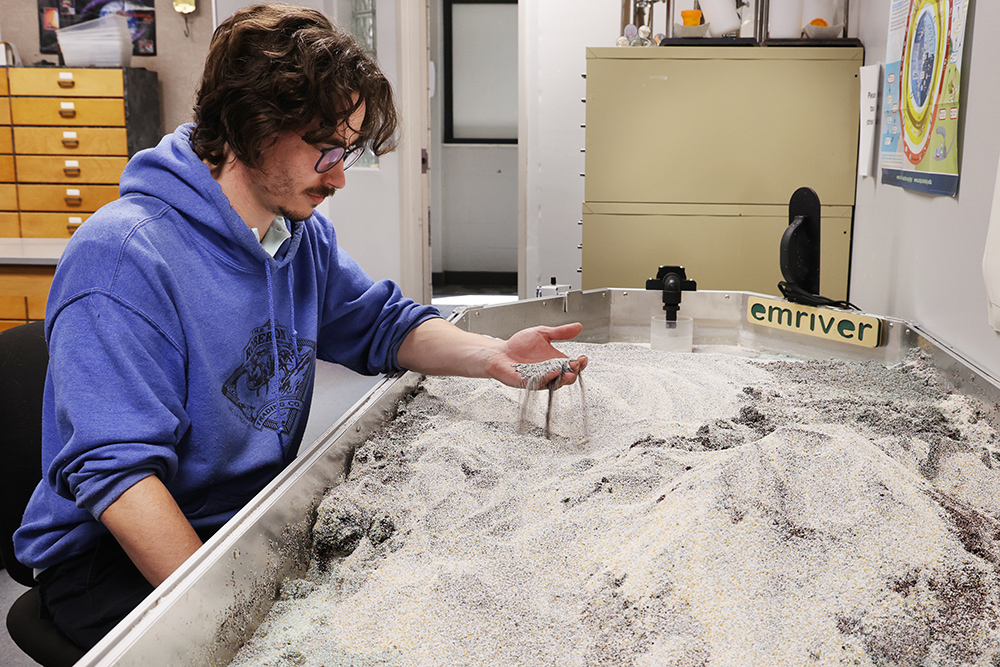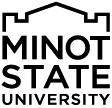SENIOR SPOTLIGHT: Hamm leaves no rock unturned

MINOT, N.D. – Minot is now home to igneous, sedimentary, and metamorphic rocks, scattered under bridges and along riverbanks, deposited by the last glacial till that carried them from across Canada.
Spend just a few minutes with Jared Hamm, and you’ll definitely learn something new about geology.
The Warman, Saskatchewan native came to Minot State originally to play hockey for the Beavers as an undeclared major, but the whim to create a terrarium changed his course and focus.
“It’s kind of a funny story,” he said. “I was bored one day and wanted to make a terrarium, basically put some plants in a jar. I went to get some rocks by the river to decorate the inside. My dad is a civil engineer, so he knows a lot about rocks and minerals, so I would point out different rocks that he might know or identify. The north has a pretty wide variety of rock and really old metamorphic rock units. So, you get to see some pretty cool things here. I started to question, curious me, ‘Oh, I remember this, I think it's quartz, but this rock looks really similar, but I don’t think it's quartz.’ Led me to a rabbit hole of mineral identification, and that led to me taking one of the geoscience classes. It kind of put all the pieces together.”
Hamm continued his quest for knowledge and shifted his focus to geology.
“I had no specific goal in mind in terms of what major I wanted to focus on; geology just kind of fit in terms of having an amazing learning environment,” he said. “Getting into geoscience was really refreshing because I had taken an online semester through the U of S (University of Saskatchewan) during COVID, which didn’t go so well. There were 300 students in most of my classes, because they were all entry-level freshman courses. Your professors don’t know you, even less so if you’re a face on a screen.
“So being able to have the in-person experience (at Minot State) with excellent teachers who are engaging and want to get to know you, really makes the learning experience more enjoyable.”
Not only did Hamm find his major, but he found love.
“I chose to stay here,” he said. “A big reason for that would be meeting my now wife, Madalyn (Meagher), (a social work major, who is also graduating this year). We ended up taking a first-year experience course together, and we got married on June 1 last year.”

During his time in the geology program, Hamm has spent the past two years working on a water quality survey funded by the National Institute of Health (NIH).
“It really represents the first actual full-blown scientific investigation that I’ve done,” he said. “The last year and a half of collecting water samples, chemically analyzing what’s actually in the water, and putting it all together and trying to write a scientific paper. That’s what science is all about.”
In order to collect enough data, Hamm worked over the summer to gather more samples from Lake Darling.
“I ended up staying here this summer, working with Dr. Collette (MSU associate professor Joseph Collette),” he said. “We collected samples once a week, every week, through the summer, but we collected from four different locations. We would have 11 samples total from those four locations. I think we were up to 16 different ions we were testing for, so you have 11 samples times 16. It's like almost 200 tests to run every week. That was a full time job. That’s all I did for the summer.
“Then we would do bi-weekly, but only four total samples, one from each location, during the school season. We wouldn't have time to go down there and do that all the time and do the tests themselves. We have probably a couple 100,000 data points done over two years.”
With all the data collected, all that was left was to apply his research to his final research paper.
“It’s been really eye-opening in terms of the importance that’s placed on details for everything from actually doing the science itself to writing the paper,” Hamm explained. “The testing, you just follow the instructions, ensure you don’t miss any steps, and record what you get, but being able to summarize it all has really shaped my thinking process. Now you have to put the pieces together in order. It’s almost like a second language.”
From the lab to a written scientific paper and presentation, Hamm had the opportunity to share his research at a national conference, the National Ideas Symposium of Biomedical Research Excellence (NISBRE), in D.C., and the state conference, the North Dakota Academy of Science, at the University of North Dakota.
“There was a lot to be compiled,” he said. “I recently presented my research, and there was another student working with me, Nikita Neyshtadt. He’s going to present next year, and his focus will be on just the physical data itself, where I only did the chemical. There’s just so much stuff to actually show.
“I’m really thankful to Dr. Collette for giving me those opportunities to present at the conferences because not every student gets that opportunity.”

Outside the classroom, he discovered a hands-on hobby that deepened his appreciation for geology.
“I got into lapidary and tumbling equipment on my own, knowing what I know about rocks and identification,” Hamm said. “There are a lot of pretty rocks that people use in jewelry, and I kind of got into making jewelry. I’m not making every stone I polish into jewelry, but cutting and polishing stones because a lot of them are very beautiful. I essentially started a mineral collection.”
Hamm applied his lapidary hobby in the geology club, A.U.G.I.T.E. Club (Association of Undergraduate Geologists in Industry, Technology, and Education), and helped others discover the fun of working with stones.
“A previous student, Michael (Quinn ’23), restarted the club and told me about it (A.U.G.I.T.E.), and he kind of got into it with me,” he said. “We had some tumblers and started tumbling rocks for fun, and I got into all the cutting and polishing stones. We ended up getting a donation from a lapidary company for a flat lab, essentially it’s a disc that spins, and the disk has grit on it, and depending on the coarseness of the grit, you can basically remove all the scratches, and eventually it’s a nice polished stone. I’ve got hundreds of them now.”
After graduation, Hamm has a full schedule ahead, including a summer internship prospecting for uranium minerals in the Northern Canadian wilderness’s Athabasca Basin at CanAlaska.
“Junior mining companies typically don’t run or operate mines themselves; they do the exploration work,” he explained. “It's not necessarily unexplored territory. A lot of it has been mapped out, but if you're looking for specific minerals, you have to go to certain areas and then spend time drilling core. If you find a spot with the mineral you’re looking for, then you start drilling and find the footprint or outline of the ore body. Once you have a rough volume, you can find the percentage of how much of the mineral you’re looking for is present. I’ll probably be doing a lot of drilling or logging the core. Marking out distances on cores and indicating where there are specific mineral groups of interest.”
Because of the remote location, the mining company has a short window of time to drill.
“It’s a lot of work since you can’t always drill throughout the year,” Hamm said. “It gets really cold. Lots of snow. So you have to do as much as you can when you have the opportunity, which can lead to really long hours. Since it’s so remote, it costs a lot of money to get employees in and out. I think my schedule is set to be three weeks in, one week out.”
Hamm will attend graduate school after his internship with CanAlaska and offers words of encouragement to future geology students.
“I was just accepted for a master’s program at the University of Saskatchewan starting in the fall,” he said. “Get out and go exploring more. A geologist is only as good as the number of rocks he’s looked at.”

About Minot State University
Minot State University is a public university dedicated to excellence in education, scholarship, and community engagement achieved through
rigorous academic experiences, active learning environments, commitment to public service, and a vibrant campus life.
Published: 05/13/25



